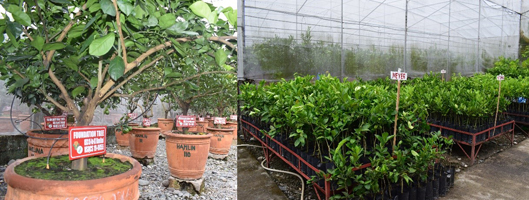
Nueva Vizcaya State University (NVSU) has established a production system for citrus quality planting materials (QPM) that can be readily accessed by citrus growers in the country.
The system includes a citrus mother tree foundation and budwood increase block, where trees are maintained in large earthen pots inside an insect-proof screenhouse. All mother trees are protected from two insect vectors: aphids for Citrus Tristeza Virus (CTV) and psyllids for Huanglongbing (HLB). CTV and HLB incidence, along with poor orchard management, are the main causes of low production of citrus in the country.
All mother trees are indexed for CTV and HLB annually to ensure that budwoods for seedling production in the nursery come from clean mother trees. The said trees have also been certified by the Bureau of Plant Industry (BPI) with tags indicating the true identity of the variety.
The production system for citrus QPM was developed through the project, “Establishment of quality planting materials production system for citrus in Nueva Vizcaya” funded by the Philippine Council for Agriculture, Aquatic and Natural Resources Research and Development of the Department of Science and Technology (DOST-PCAARRD). The project enhanced the nursery and screenshouse facilities of NVSU and increased capacity from 3,000 to 5,000 seedlings to over 7,000 to 10,000 seedlings per year.
Moreover, the indexing laboratory has become fully equipped with protein-based and molecular-based protocols. As a result, the laboratory has been used as a service facility for mother trees of NVSU’s Philippine Citrus Resources Development Center (PCRDC), private orchards, and nurseries in the province.
The molecular-based detection for HLB involves the use of a probe that matches a sequence in the bacterial DNA (deoxyribonucleic acid). With positive detection, a polymerase chain product of 228 base pairs appears as a band. Disease detection for mother trees takes only 2–3 days.
Current efforts of NVSU on disease indexing through PCRDC is opening opportunities to provide services in the Cagayan Valley Region.
Also, PCRDC through the project, capacitated the local government unit of Kasibu, Nueva Vizcaya in grafted citrus seedling production. The project provided assistance to the Municipal Agriculture Office (MAGRO) by enhancing its screenhouse and linking them to NVSU’s QPM system.
The development of the QPM system was an effort that progressed from the support of other government agencies that include the Department of Agriculture-Bureau of Agricultural Research (DA-BAR), Commission on Higher Education-Integrated Research Utilization Program (CHED-IRUP), and Department of Labor and Employment-Adjustment Measures Program (DOLE-AMP).
